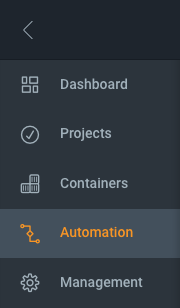Vulnerability Management (InsightVM) Automation Features
Feature availability notice
Rapid7 no longer offers Built-in Automation Workflows for new Vulnerability Management (InsightVM) customers. This feature is available to eligible Vulnerability Management (InsightVM) users only. If interested in this feature, see our Exposure Command offering .
Not available in InsightGovCloud
This feature is not available for InsightGovCloud customers.

As a platform-enabled Vulnerability Management (InsightVM) customer, you can take advantage of multiple Automation features that allow you to eliminate most of the manual tasks involved in addressing security needs in your environment. These capabilities include both internal Vulnerability Management (InsightVM) functions and external tool orchestration via Workflows.
Vulnerability Management (InsightVM) offers the following configurable Automation options:
Notifications
Contained entirely within Vulnerability Management (InsightVM), configure Notifications to alert both internal and external team members to detected changes affecting your assets. Choose between communication methods such as email and text messaging to keep your team informed.
Workflows
REQUIRED
You must install and activate an Rapid7 Orchestrator (Insight Orchestrator) to run Workflows. See our orchestrator help page for instructions.
Driven by the Rapid7 Orchestrator (Insight Orchestrator), configure Workflows to eliminate the significant lag time and tasking normally associated with asset containment and remediation. Vulnerability Management (InsightVM) includes several ready-made Workflows built for industry-leading third party solutions (such as Automation-assisted patching with IBM BigFix and Microsoft SCCM) that you can use to quickly address emerging security needs.
Understanding triggers
Before you get started with your first Automation, it’s important to understand how and when they decide to run. All Vulnerability Management (InsightVM) Automations are designed to run on triggers. Automation triggers are made of queries applied to your assets and the vulnerabilities found therein. These queries can be as broad or focussed as you require, and proper use will help you get the most out of Automation in InsightVM.
Check out our Query Guide to learn how to build Automation triggers effectively.
Take a quick tour of the Automation page
Click the Automation tab on your navigation menu. Before we dive in to each Automation type in detail, feel free to familiarize yourself with the landing page and the information it holds.
History
Your Automation page opens to this view by default. The History tab is a consolidated view of all the trigger instances for each of your configured Automations, regardless of type.
Filters
The “Filters” panel holds several filter options, including raw search, date range, and status selectors. Apply one or combine several for an increasingly granular view of your trigger instances.
Manage Connections button
Click Manage Connections to check the health status, job count, and resource usage of your installed orchestrators.
+ New Automation button
Click + New Automation to start the Automation creation wizard. Automations of all types are created this way. Be sure to read our individual Automation pages for instructions on using the wizard in each scenario.